Moto X Review
by Brian Klug on August 26, 2013 1:30 PM EST- Posted in
- Smartphones
- Qualcomm
- MSM8960
- Motorola
- Android
- Mobile
- Android 4.2
- Moto X
Battery Life
Battery life is a huge concern in the smartphone space these days, especially as phones get bigger and more powerful. The Moto X includes a unique 2200 mAh, 3.8 V (8.36 Whr) stacked battery made by LG chem, which maximizes battery volume given the Moto X’s rounded form factor. Motorola was very vocal about the battery life of the Moto X, and made the claim of up to 24 hour of mixed use with the device in addition to up to 13 hours of call time. Given the smaller (albeit AMOLED) display and dual core SoC, the Moto X was an easy target for the narrative that higher end specs and quad core SoCs are killing smartphone battery life, which many immediately latched onto and parroted claims of amazing battery life.
Of course, the real question is how the Moto X stacks up to the competition in our objective tests. I have to admit that my initial subjective impressions of the Moto X battery life were not all that great. My first time daily driving the Moto X was after getting it in NYC and flying home – I left the hotel with it fully charged, spent 4 hours in a plane with it in airplane mode, and Moto X still died in the baggage claim before I could make it home. The second time I daily drove the Moto X, I also managed to kill it doing nothing out of the ordinary before I got back home. I honestly can’t remember the last time I drained a phone completely actually using it. Since those couple of times I haven’t had problems making it through a full day when I’ve daily driven the Moto X, but that’s with my usual opportunistic charging from every available wall socket and USB port, and my mixed use definitely isn’t 24 hours, rather closer to 8.
Our objective battery life tests are unchanged so I’m not going to go through all of it in excruciating detail again – you can read any previous review and get the details. At a high level we calibrate the display to exactly 200 nits, then run through a bunch of webpages with content every dozen or so seconds until the device dies, on both cellular, and WiFi. The call test is self explanatory – there’s voice at both the originating terminal and terminating terminal, and we time how long the call goes for until the device dies.

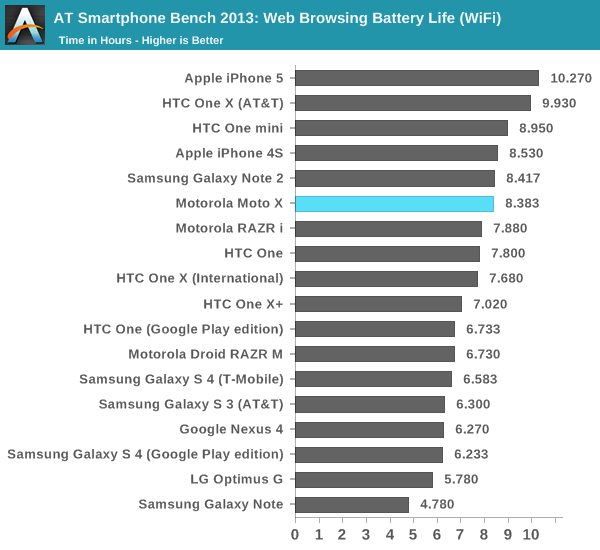
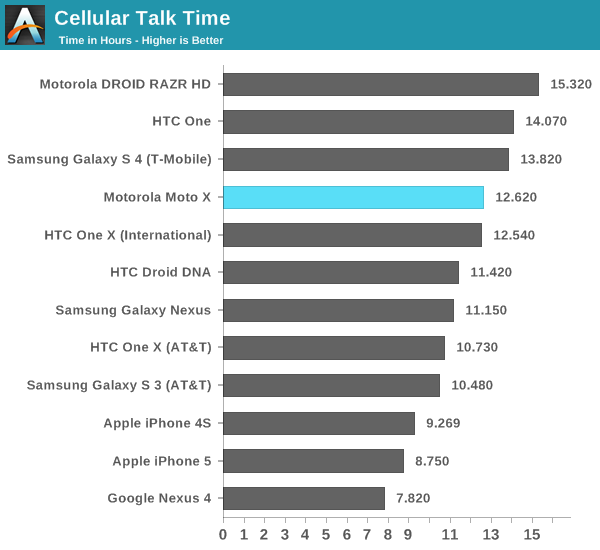
Battery life on the Moto X doesn't turn out to be all that much different from the other flagships based on APQ8064 on LTE. In fact, it's about par. That's not too surprising for me considering compared to the HTC One and SGS4 it's the same CPU (Krait 300) and process (28nm LP). For better battery life we'll need better efficiency, which will come either through newer process (28nm HK-MG variants at TSMC) or even more efficient CPU architecture.
In reality, having fewer cores here means in something multithreaded like our battery test (Chrome is very multithreaded) it needs to send the Moto X's two cores to a higher frequency and voltage state than the four on the other devices. I'm not surprised at all to see invalidation of the "fewer cores translates to better battery life" narrative others have crafted. The only validation is that having two fewer cores does translate to less dynamic range in power use. It all becomes a matter of how you're using the device at that point, however. On WiFi the Moto X does do pretty well, and Motorola has always had very good talk time.
One thing I will note is that the Moto X does have a power saver mode, but it appears to just disable background sync and put the data connection to sleep aggressively. It doesn't change the governor so that the max CPU frequency is lower (say the 1.1 GHz state) like a lot of other OEMs power savers do, which seems like a missed opportunity.
The Moto X comes with a dual-USB port 850 mA charger, like the previous revision of Motorola devices. In practice I've seen the Moto X reliably pull closer to 1 A from the Moto X bundled charger.
What's interesting however is that the Moto X can charge up to the maximum BC1.2 rate of 1.5A. If you use that kind of charger, it charges impressively fast, around 2.3 hours.
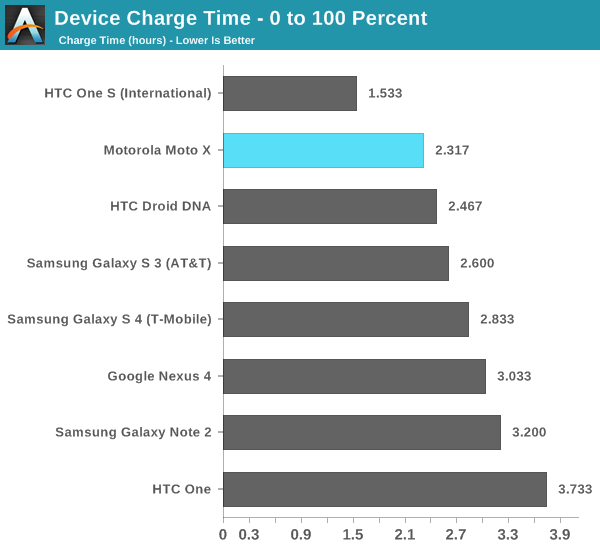


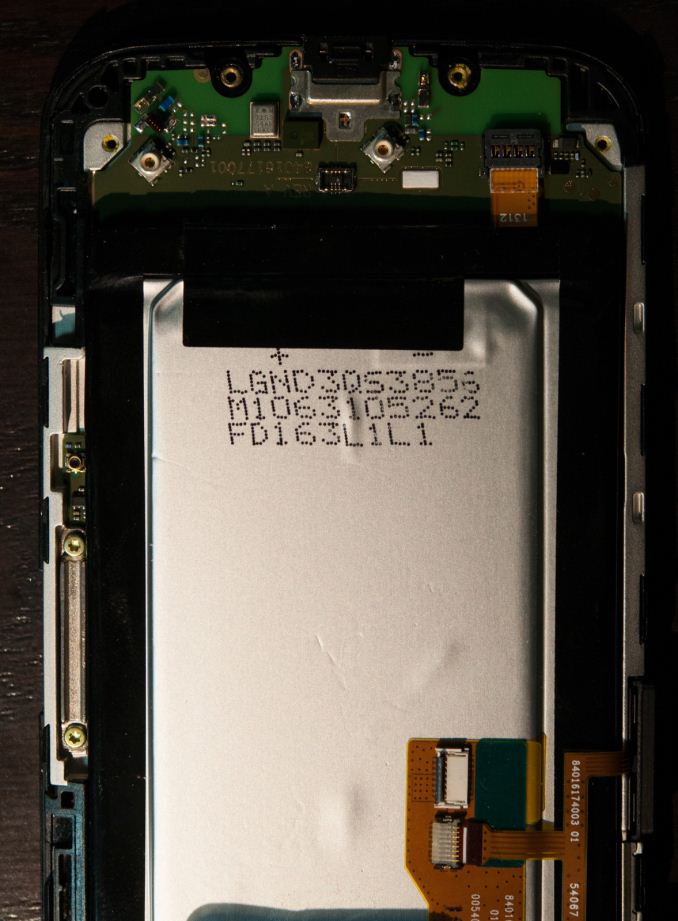
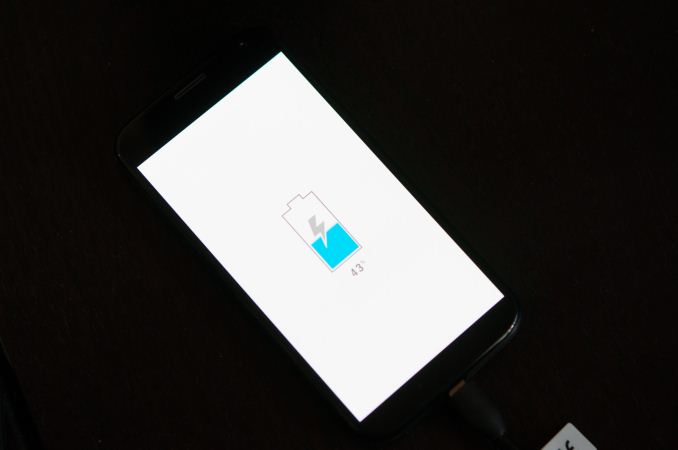








105 Comments
View All Comments
PC Perv - Monday, August 26, 2013 - link
Same for the screen. It's not as if everyone is in publishing industry. Human eyes are not limited to sRGB. Colors can be accurate or inaccurate, but there is no right or wrong ones. The author talks as if having larger gamut than sRGB in and of itself is always a negative. Ever looked into the ocean and be marveled at the nature's wonder?Friendly0Fire - Monday, August 26, 2013 - link
It is a negative if the software is not aware that the gamut is larger (hint: it isn't), causing incorrect colors.I doubt anyone at AnandTech would spit on an AdobeRGB screen if the OS and all software handled it properly, but that's just not happened and probably won't for the foreseeable future. In the meantime, accurate colors are better than higher gamut.
MartinT - Tuesday, August 27, 2013 - link
I'd argue that a large portion of what remains as a debate on optimal screen size is down to one particular supplier with considerable market share in the US not providing a model anywhere even close to what Brian (and the market) have zeroed in on as optimal.This is where Samsung's policy of trying absolutely everything comes real handy to anyone interested in cellphone trends.
quickbunnie - Monday, August 26, 2013 - link
Brian Klug didn't think he'd like the Moto X. After using it, Brian Klug liked the Moto X.Translation: This phone is frickin awesome!
Brian Klug - Monday, August 26, 2013 - link
I like it a whole lot more than I thought I would, still using it! :)-Brian
Fiebre - Monday, August 26, 2013 - link
I wish you guys could do a battery test on the Droid maxx. I would really appreciate it.icrf - Tuesday, August 27, 2013 - link
I second this point. I'm thus far assuming that, industrial design aside, all Moto X points apply to Droid Maxx, except battery life. The Verge posted their review and said the new Droid Maxx falls short of last year's Droid Razr Maxx despite having an inflated battery life number in the marketing. That said, everyone else's battery tests seem to do silly things like not calibrating the display to a standard, which means the tests are neigh useless. We need Anandtech's superior consistency.Honest Accounting - Sunday, September 15, 2013 - link
The battery test here isn't as "objective" as the reviewer claims. It uses a fixed "200 nits" screen brightness, which will favour current LCD technology (and Apple in particular) over OLED . To be credible the screen brightness on the battery test should be a percentage of maximum screen brightness.geniekid - Wednesday, August 28, 2013 - link
But would you prefer using the Moto X or the HTC One?Solandri - Monday, August 26, 2013 - link
I was a bit confused by the flash read/write performance charts. The standard in reviews seems to be to order them sequential r/w, then random r/w. I did a double take, then realized you'd ordered them write random/sequential, then read random/sequential. Different, but no big deal.Then I did a triple take and realized you'd ordered them write random/sequential, then read sequential/random. Coincidentally, this ordering is best-to-worst for the Moto X.
I trust your site's reviews enough to believe this was purely a coincidence, and that you switched the ordering because you led off by talking about the F2FS filesystem's write speed improvement (with the read speeds maintaining the traditional sequential/random order). But if you're going to switch around the order for the write speeds, you should switch the order of the read speeds to be consistent. The current ordering is not logical, and it gives the appearance of bias in favor of the Moto X.